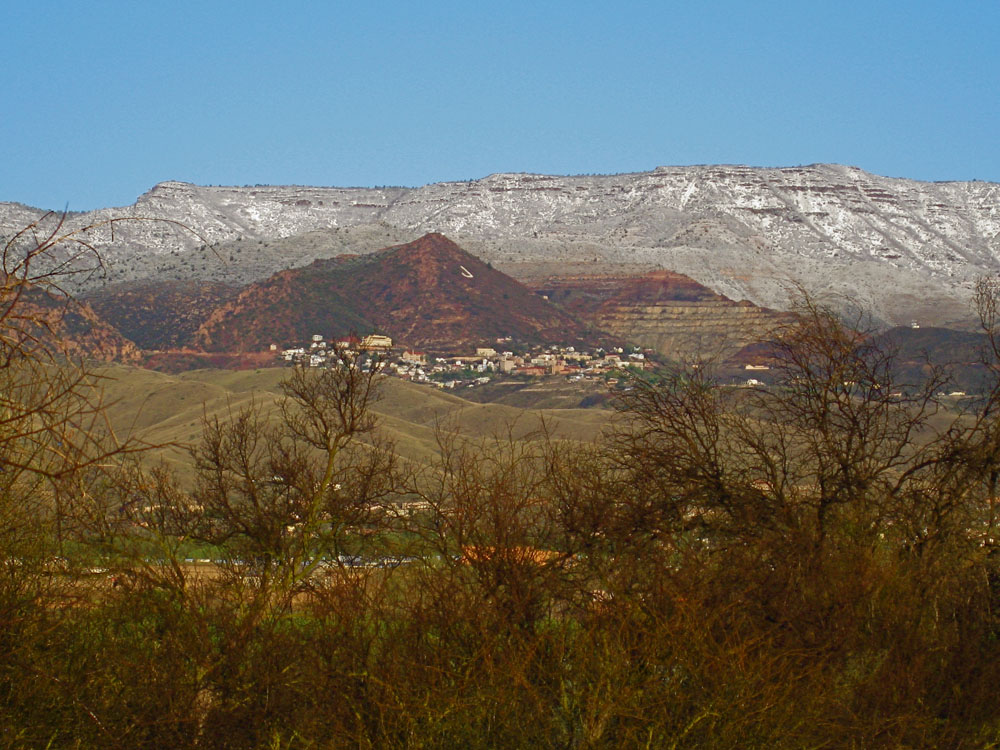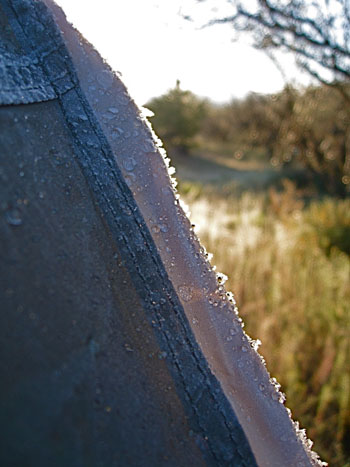Whew…
 …back from Sierra Vista and Southwest Wings Festival; tired. Nice show. Thanks to everyone who came by, and thank you to the organizers, who did a good job in a new venue. It’s always nice to see friends, returning customers, and new faces.
…back from Sierra Vista and Southwest Wings Festival; tired. Nice show. Thanks to everyone who came by, and thank you to the organizers, who did a good job in a new venue. It’s always nice to see friends, returning customers, and new faces.
To those of you on my emailing list, if you’re wondering why you didn’t get an advance email notification of the event in your inbox, it’s because I absentmindedly forgot to send out an e-flyer before the show. Hope you found your way to the Three Star Owl booth anyway!
 Right: Coati/scorpion lidded vessel with coati-tail handles (A. Shock, 2010, stoneware, 9.5″ ht)
Right: Coati/scorpion lidded vessel with coati-tail handles (A. Shock, 2010, stoneware, 9.5″ ht)
Three Star Owl is headed to Southwest Wings Festival
Come visit “The Owlet” in Sierra Vista starting tomorrow, through Saturday.
I have new Three Star Owl work to share, familiar work, unfamiliar work, and, for some reason, LOTS of MUGS!
For more event details please click here.
Three Star Owl at Verde Birdy
Here are a few images from last weekend’s event at the Verde Valley Birding and Nature Festival. If you haven’t checked out the Verde Valley in north central Arizona, you should — it’s beautiful green country, with big trees and lots  of year-round water like the Verde River, as well as surrounding mountains, good restaurants, hiking trails and birding areas, and amazing archeological sites like Montezuma Castle and Well, and Tuzigoot. Sedona, Jerome, and Prescott and their amenities are all within striking distance, and it’s all only two hours north of Phoenix and even less from Flagstaff.
of year-round water like the Verde River, as well as surrounding mountains, good restaurants, hiking trails and birding areas, and amazing archeological sites like Montezuma Castle and Well, and Tuzigoot. Sedona, Jerome, and Prescott and their amenities are all within striking distance, and it’s all only two hours north of Phoenix and even less from Flagstaff.
The weather last weekend straddled the turn of the seasons, with winter making one last stand in the form of a cold wet storm that left us shivering in the big event tent, and the peaks above Jerome dusted with snow (photo above; by A.Shock). But warm weather arrived in time for the weekend, which brought out crowds and cottonwood wool alike.
turn of the seasons, with winter making one last stand in the form of a cold wet storm that left us shivering in the big event tent, and the peaks above Jerome dusted with snow (photo above; by A.Shock). But warm weather arrived in time for the weekend, which brought out crowds and cottonwood wool alike.
<< Hoarfrost and frozen raindrops on the tent; it was 24F at night! Brrrr… (Photo A.Shock)
This is one of the few sales events I camp at, because it’s held in Dead Horse Ranch State Park, just outside of Cottonwood AZ. Here’s the view from the campground, of Tuzigoot National Monument. The rangers from the Montezuma Castle/Well/Tuzigoot parks complex had their  info booth next to mine, and I heard them calling this park “the Goot”. Unlike in the low desert, where the mesquite are newly green, the bosque in the foreground was still quite bare and gray. (Photo A.Shock) >>
info booth next to mine, and I heard them calling this park “the Goot”. Unlike in the low desert, where the mesquite are newly green, the bosque in the foreground was still quite bare and gray. (Photo A.Shock) >>
This made it easy to spot the early-returning migrants, such as this Gray flycatcher. If you  despair identifying Empidonax flycatchers, rejoice in the easy-to-ID Gray, whose gentle downward tail wag is distinctive, along with other field marks such as gray back, bold eyering and wingbars, and yellow lower mandible. (Photo E.Shock) >>
despair identifying Empidonax flycatchers, rejoice in the easy-to-ID Gray, whose gentle downward tail wag is distinctive, along with other field marks such as gray back, bold eyering and wingbars, and yellow lower mandible. (Photo E.Shock) >>
Along with gila monsters, coatis, roadrunners, and lots more, the Three Star Owl booth was positively stuffed with owls, maybe even more than usual. Below are some owl jars, effigy vessels, whistles, and salt and pepper shakers.
It was a good event for “The Owl”, and my thanks to everyone who came by for a visit, or to take a new treasure home with them.
See you at Southwest Wings in early August!
Three Star Owl at Verde Birdy this week
 Later this week is the Verde Valley Birding and Nature Festival in Cottonwood Arizona. The event is held each year in Dead Horse Ranch State park, which is OPEN (unlike some other Arizona state parks!).
Later this week is the Verde Valley Birding and Nature Festival in Cottonwood Arizona. The event is held each year in Dead Horse Ranch State park, which is OPEN (unlike some other Arizona state parks!).
Three Star Owl will be there, with a pithy assortment of one of a kind, hand made clay items from Gila Monster mugs to Javelina salt and pepper shakers to Hummingbird vases and more!
If you’re in the area, please stop by — there’s an admission fee for entering the state park, but the event is free. Vending hours — under the “Big Top” are: thursday 22apr 9-5.30; friday 23apr 9 – 5; saturday 24apr 9-5; and sunday 25apr 9-1.
Hope to see you there!
Click HERE for more information.
Nudging clay horned lizards along
A while back, I posted about my process for making horned lizard bowls (affectionately known as Horny toads) from clay. Here are the next few steps, all shown in one photo, below.
To the right is a now completely assembled and textured horned lizard, in the leather hard stage, drying. In the center is a bone dry and partially tinted lizard — note that the clay is now a lighter buff. I use a sponge and mute slip colors to give the textured skin a mottled appearance, like a horned lizard’s camo-flecked pelt. (You may remember that slip is a paint-like water and clay mixture with mineral oxides and stains added.) The colors, which look very contrasty and unnatural at this point, will calm down and become more subtle during firing. Normally, adding slip is done no later than the leather hard stage to avoid flaking, but the refined slips I use  have no problems hanging on. On the left is a completed horned lizard awaiting its first, or bisque, firing. I’ve added the ants with a very fine brush (a 00 squirrel liner), also in slips. This is a touchy job: the fine work requires a fairly long process of painting delicate lines — the more ants, the longer the work time — and a lot of handling of a bone dry piece with pointy sticky-outy bits. If you’ve worked with clay you know that this bone-dry phase (where all the liquid water has evaporated from the clay body) is when a piece is at its most fragile. On top of that, if something like a horn, a toe or a leg snaps off, it
have no problems hanging on. On the left is a completed horned lizard awaiting its first, or bisque, firing. I’ve added the ants with a very fine brush (a 00 squirrel liner), also in slips. This is a touchy job: the fine work requires a fairly long process of painting delicate lines — the more ants, the longer the work time — and a lot of handling of a bone dry piece with pointy sticky-outy bits. If you’ve worked with clay you know that this bone-dry phase (where all the liquid water has evaporated from the clay body) is when a piece is at its most fragile. On top of that, if something like a horn, a toe or a leg snaps off, it  is difficult or even impossible to reattach it trustworthily. Not that… ahem… that ever happens, or if it did I would admit it… These guys, Regal Horned Lizards, have 10 coronal horns, and so I have to be careful while “anting” them.
is difficult or even impossible to reattach it trustworthily. Not that… ahem… that ever happens, or if it did I would admit it… These guys, Regal Horned Lizards, have 10 coronal horns, and so I have to be careful while “anting” them.
<< A favorite teeshirt of E‘s, a mimbres horned lizard design. Nice depiction of the lateral spiny scales along its flanks.
A note on the ants. They are Pogonomyrmex, a genus of harvester ants, called Pogos for short, understandably. These are the guys you see issuing forth from their nests, with every seed and scrap of vegetation gleaned clean to the grit for a 5 meter radius around the entrance. They have a potent and painful bite, but despite that, they are Horned lizards’ most favoritest thing to eat. It’s tough to capture their essence in a sludgy, opaque medium like clay slip, because they’re waxy like tropical fruit: sort of clear but satiny, too. I can get close to the effect by depicting them with highlights in white on their red bodies.
Pogonomyrmex ants photographed at Kartchner Caverns State Park (A.Shock) >>
They’re extraordinary animals: physically very strong, and focused in their social pursuits, with big bolster-like heads (which appear to be larger than their abdomens) sporting impressive grasping mouthparts you would have no trouble seeing with your naked eye, if you got close enough. Or, you can just click on the photo above — which I call Pogos Agogo — and look at the solitary ant to the lower left.
If you love excellent up-your-nose close-up photos of ants (and who doesn’t?) check out the site of Alex Wild, myrmecologist, or studier of ants. Better still click here to see his photos of Pogo ants in particular, to get a much better view of the fearsome mouthparts than in my photo above.
Etymological side-bar. In Homer’s Iliad, Achilles’ posse were the Myrmidons. μύρμηξ, myrmex, is ant in Greek.
You can see finished horned lizard bowls in the Three Star Owl Shop.
Squeezing out horned lizards from clay
 A new batch of clay horned lizards under way — early steps:
A new batch of clay horned lizards under way — early steps:
From top to bottom:
1) Rough out body shape by pinching; head and tail included in starting clay lump.
2) Create appendages: horns, limbs. Allow to “set up” or slightly stiffen, while: refining body shape of liz.
3) Further refine body shape; note detail in head, side fringe.
The next steps are where time starts becoming a factor — these guys won’t “hatch” for quite a while yet. Stay tuned!
(Photos A.Shock)




